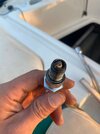mejim707
Active Member
So I'm out today and the boat is running awesome, but suddenly it would randomly shut off while at speed, or just idling. I'd pull the key and put it back on the post, hear the beep, and it would fire right back up and run fine.
This happened a number of times. The last time it happened however I pulled the key, popped it back on the post and nothing. No beep, no lights, nothing! I did this a bunch of times and I had no response as I floated away into oblivion. Oh Crap!!
So, I grabbed the post, jiggled it heavily, then put the key on and I got the beep, started and I headed right to the dock.
Got home and the key wouldn't activate at all. I tried it about 7 times. Pulled the console storage container and reseated the post cable connector. No dice, I played with the fob and post a little and finally got the beep. I was able to get it working consistent enough to flush the engine.
No bueno my friends. No bueno at all!
So, could the key fob or post be causing this and do these go bad? Can I change the post or is it programmed to the MPEM?
Any advice on how to test this would be awesome!
Thank you in advance!
This happened a number of times. The last time it happened however I pulled the key, popped it back on the post and nothing. No beep, no lights, nothing! I did this a bunch of times and I had no response as I floated away into oblivion. Oh Crap!!
So, I grabbed the post, jiggled it heavily, then put the key on and I got the beep, started and I headed right to the dock.
Got home and the key wouldn't activate at all. I tried it about 7 times. Pulled the console storage container and reseated the post cable connector. No dice, I played with the fob and post a little and finally got the beep. I was able to get it working consistent enough to flush the engine.
No bueno my friends. No bueno at all!
So, could the key fob or post be causing this and do these go bad? Can I change the post or is it programmed to the MPEM?
Any advice on how to test this would be awesome!
Thank you in advance!





